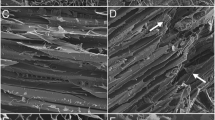Abstract
Halos were detected with epifluorescence microscopy around penetration sites of Colletotrichum dematium f. circinans and Botrytis allii in onion epidermal cell walls as areas of less intense fluorescence or negatively stained areas in fluorescing cell walls following treatments with berberin sulphate and acridine orange but not with brilliant sulphaflavine (which stained the cell wall), ninhydrin, dansylchloride, or analine blue. Since pectin, pectic acid, avacil (microcrystaline cellulose super fine), filter paper, and Sephadex G-100–120 fluoresced with acridine orange and berberin sulphate, it was inferred that the halos were negatively stained or appeared as areas with less intense fluorescence because enzymes from these pathogens degraded cell wall pectin and cellulose at the point of penetration. Spores of both pathogens fluoresced when stained with brilliant sulphaflavine, acridine orange, ninhydrin, and dansylchloride. These stains and berberin sulphate caused germ tubes, appressoria, and primary infection mycelia to fluoresce. Nuclei in these fungal structures fluoresced when stained with acridine orange and brilliant sulphaflavine.
Similar content being viewed by others
References
Akai S, Kunoh H, Fukutomi M: Histochemical changes of the epidermal cell wall of barley leaves infected by Erysiphe graminis hordei. Mycopathologia et Mycologia Applicata 35:175–180, 1968.
Aronson JM: Cell wall chemistry, ultrastructure and metabolism. In: Cole GT & Kendrick B (eds) Biology of Conidial Fungi Vol 2:459–507, 1981.
Bhattacharya PK, Pappelis AJ: Cytofluorometric study of onion epidermal nuclei in response to wounding and Botrytis allii infection. Physiol Plant Pathol 21:217–226, 1982.
Bhattacharya PK, Pappelis AJ: Nucleic acid, protein, and protein-bound lysine and arginine patterns in epidermal nuclei of the mature and senescing onion bulb. Mech Ageing Dev 17:27–36, 1983.
Bradley DF, Wolf MK: Aggregation of dyes bound to polyanions. Proc Nat Acad Sci of USA 45:944–952, 1959.
Currier HB, Strugger S: Aniline blue and fluorescence microscopy of callose in bulb scales of Allium cepa L. Protoplasma 45:552–559, 1956.
Jensen WA: Botanical Histochemistry. Freeman Co, San Francisco, 1962.
Kritzman G, Chet I, Gilan D: Spore germination and penetration of Botrytis allii into Allium cepa host. Bot Gaz 142:151–155, 1981.
Kunoh H, Akai S: Histochemical observation of the halo on the epidermal cell wall of barley leaves attacked by Erysiphe graminis hordei. Mycopathologia et Mycologia Applicata 37:113–118, 1969.
Lillie RD: H. J. Conn's Biological Stains, eight edition. Waverly Press, Inc Baltimore, Md, 1969.
Mayama S, Pappelis AJ: Application of interference microscopy to the study of fungal penetration of epidermal cells. Phytopathology 67:1300–1302, 1977.
McKeen WE, Smith R, Bhattacharya PK: Alterations of the host cell wall surrounding the infection peg of powdery mildew fungi. Can J Bot 47:701–706, 1969.
Rigler RJ: Microfluorometric characterization of intracellular nucleic acids and nucleoproteins by acridine orange. Acta Physiol Scand 67 (suppl) 267:1–122, 1966.
Ruch F: Principles and some applications of cytofluorometry. In: Wied GL & Bahr GF (eds) Introduction to quantitative cytochemistry II. Academic Press, New York, 1970, pp 431–450.
Russo VM, Pappelis AJ: Observations of Colletotrichum dematium f. circinans on Allium cepa: halo formation and penetration of epidermal walls. Physiol Plant Pathol 19:127–136, 1981.
Selevendran RR: Analysis of cell wall material from plant tissues: extraction and purification. Phytochem 14:1011–1017, 1975.
Shumway CR: Changes in the epidermal cell wall of onion (Allium cepa L.) induced by penetration of Botrytis allii Munn. MS thesis, Southern Illinois University, Carbondale, Illinois, USA, 1981.
Shumway CR, Russo VM, Pappelis AJ: Germination and post-germination development of Colletotrichum dematium f. circinans on Allium cepa. Mycopathologia 82:125–127, 1983.
Traganos F, Darzynkiewicz Z, Sharples T, Melamed MR: Simultaneous staining of ribonucleic and deoxyribonucleic acids in unfixed cells using acridine orange in flow cytofluorometric system. The J of Histochem and Cytochem 25:46–56, 1977.
Author information
Authors and Affiliations
Rights and permissions
About this article
Cite this article
Karabetsos, J.H., Pappelis, A.J. & Russo, V.M. Visualization of halos in the epidermal cell wall of Allium cepa caused by Colletotrichum dematium f. circinans and Botrytis allii using fluorochromes. Mycopathologia 97, 137–141 (1987). https://doi.org/10.1007/BF00437236
Issue Date:
DOI: https://doi.org/10.1007/BF00437236




